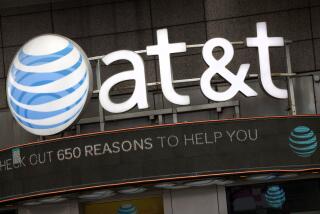AT&Tâs Sponsored Data program probably wonât reduce your bill
AT&T has come up with a new way to make money off Netflix, Google and other companies that stream content onto mobile devices: Have them pay for subscribersâ wireless access.
Think of it as a toll-free 800 number for streaming audio and video.
The telecom giantâs so-called Sponsored Data program is intended to make wireless users less squeamish about accessing data-heavy services that can quickly chew up their minutes under many plans.
Hereâs the thing: If other wireless providers follow suit â and they probably will â it will give an advantage to big content companies that can subsidize peopleâs listening and viewing. Smaller companies and start-ups would be hard-pressed to compete.
Whatâs more, this doesnât really address the biggest problem. Everyoneâs Internet access charges for wireless and fixed lines are soaring even though only a handful of streaming video services account for the lionâs share of usage.
Netflix is responsible for almost a third of North American cable and phone-line Internet traffic from 9 p.m. to 12 a.m., according to network management firm Sandvine. Add YouTube into the mix, and the two services make up just over half of prime-time Net traffic.
When it comes to wireless, YouTube is the big dog, accounting for 27% of data streaming.
Netflix represented just 4% of wireless streaming in the first half of last year, Sandvine said. But thatâs double the companyâs total in the same period a year earlier, indicating rapid growth among users of mobile devices.
Tom Wheeler, chairman of the Federal Communications Commission, said Wednesday that the agency would watch closely to see how AT&Tâs program plays out.
âBe sure,â he said, âthat if it interferes with the operation of the Internet, that if it develops into an anti-competitive practice, that if it does have some kind of preferential treatment given somewhere, then that is cause for us to intervene.â
The last thing authorities want is for network providers to pick winners and losers among content providers.
AT&T clearly sees that there are big bucks to be made in wireless data streaming. In the third quarter last year, the company said, data revenue hit $5.5 billion, up nearly 18% from the same three months a year earlier. Almost 1 million wireless subscribers were added in the quarter.
âThe future for us ⌠is about building a video delivery capability,â AT&T Chief Executive Randall Stephenson said at a recent investor conference. âAnd thatâs where the capital is going to be going over the next three years.â
What he means is the company will be building out its wireless network, and subscribersâ monthly fees will largely foot the bill.
Yet why should everyone be saddled with the same financial burden when the wireless airwaves are dominated by users of just a few services?
If you mostly send text messages rather than watch episodes of Netflixâs âHouse of Cards,â why should you be equally responsible for your service providerâs need for additional capacity?
Digital rights advocates make a big deal of whatâs known as net neutrality, the idea that all content should be considered equal in the eyes of network providers. That is, a Netflix or Google shouldnât be able to pay more to network operators like AT&T for their content to receive special treatment.
I get it. Itâs better if online services compete on a level playing field.
AT&T says its Sponsored Data wonât be any faster than other content and thus wonât violate federal net neutrality rules. Verizon, for its part, is suing to overturn those rules and expects a verdict in coming weeks.
In any case, it seems pretty clear that streaming video places the greatest strain on telecom networks.
The average broadband Internet customer pays about $41 a month for service, according to the WhiteFence Index of utility charges. If youâre a Netflix subscriber or a heavy YouTube user, that may seem like a pretty good deal.
If youâre not into streaming video, youâre still helping pay for your Internet service providerâs network costs so that others can watch all those data-dripping movies and TV shows.
AT&Tâs Sponsored Data program addresses this unfairness in a limited way by shifting some wireless costs to the content provider. Ralph de la Vega, head of AT&T Mobility, called this âa win-win for customers and businesses.â
âCustomers just look for the Sponsored Data icon and they know the data related to that particular application or video is provided as a part of their monthly service,â he said.
The upshot, however, is that more people will download rivers of data onto wireless devices. This will require more network capacity, which may not be covered by whatever fees content providers pay into the Sponsored Data program.
Net neutrality notwithstanding, the reason that coach seats on airlines cost a lot less than first class is because you get far less service and comfort. People who arenât using their computers or mobile devices as home theaters shouldnât be paying the same prices for Net access as people who are.
âWhile Sponsored Data will be pitched as a way to save customers money, itâs really just double charging,â said Matt Wood, policy director of the advocacy group Free Press. âThe customer is still paying for the connection and wonât get a refund just because Facebook or YouTube or ESPN are also paying for some data usage now.â
Think of it like this: Toll-free 800 numbers â an AT&T invention â originated in the 1960s. Since then, your land-line phone bill has only gone up.
Toll-free wireless streaming might seem like a money-saver, but itâs unlikely your monthly bill will go down.
Whatâs needed is a system that requires people who drink deepest from the Internet, either by fixed line or wireless device, to pay more to slake their digital thirst.
Or everyone else should pay less.
David Lazarusâ column runs Tuesdays and Fridays. He also can be seen daily on KTLA-TV Channel 5 and followed on Twitter @Davidlaz. Send your tips or feedback to [email protected].
More to Read
Inside the business of entertainment
The Wide Shot brings you news, analysis and insights on everything from streaming wars to production â and what it all means for the future.
You may occasionally receive promotional content from the Los Angeles Times.










